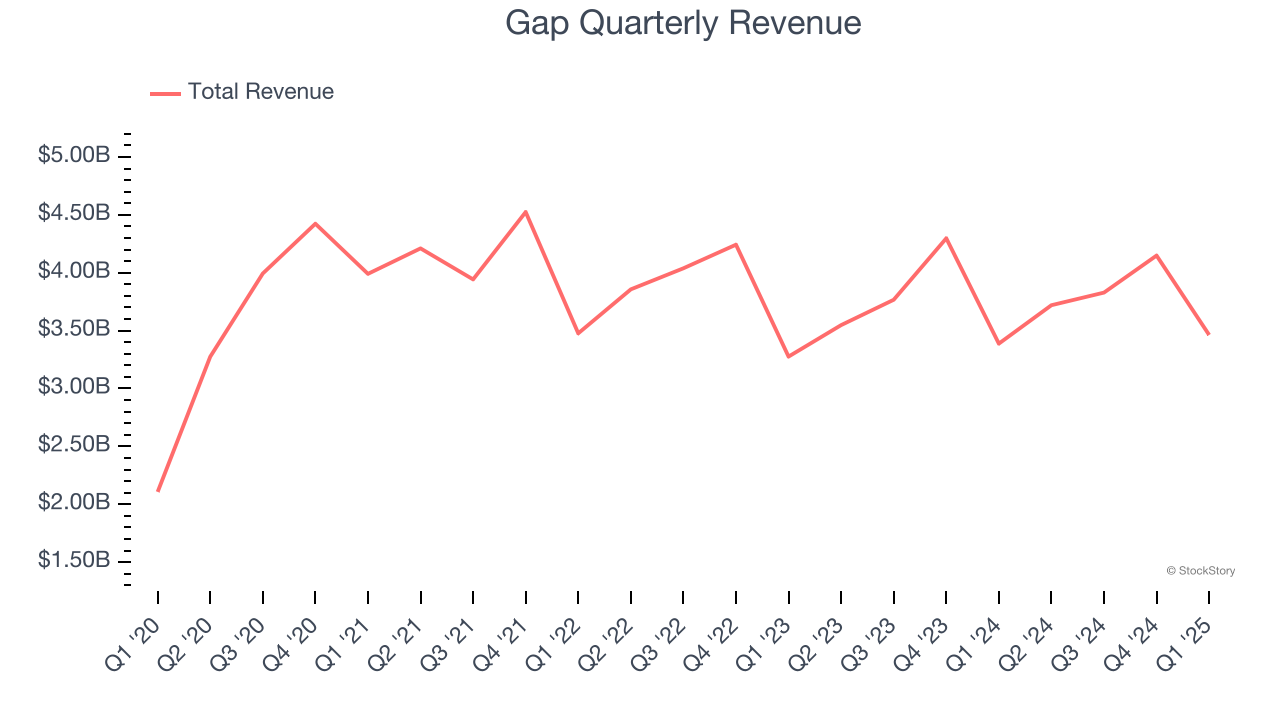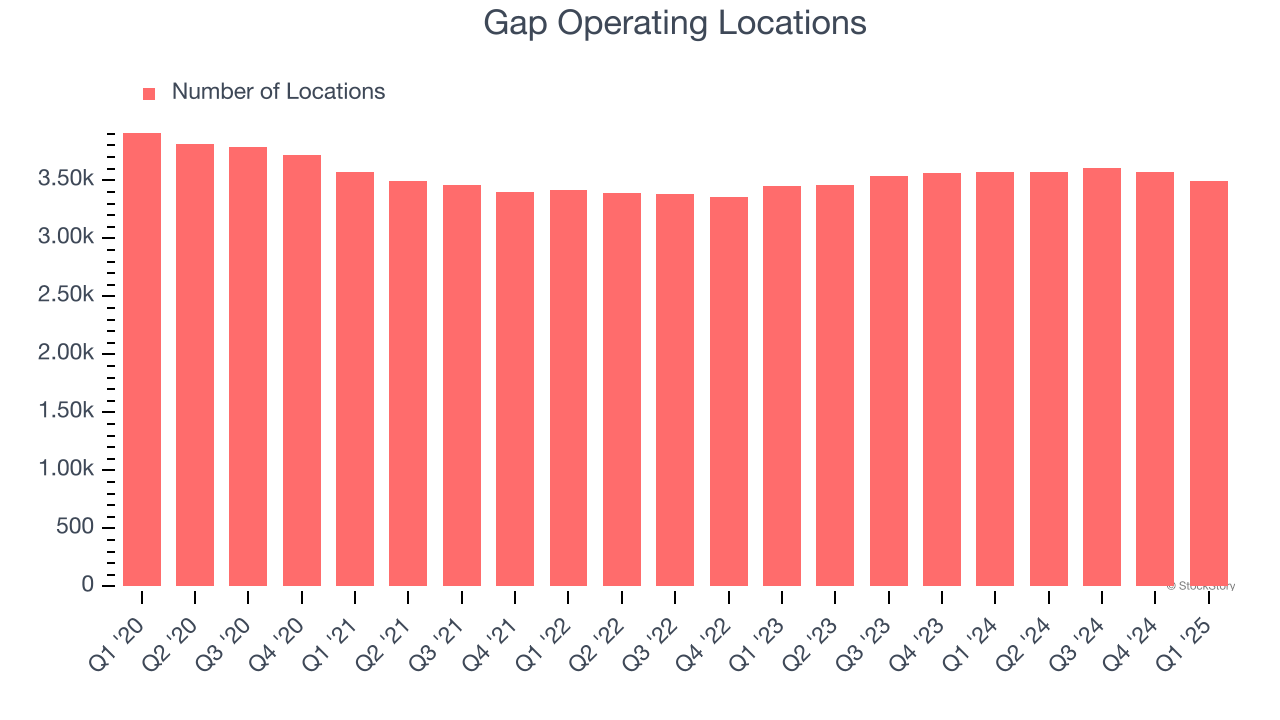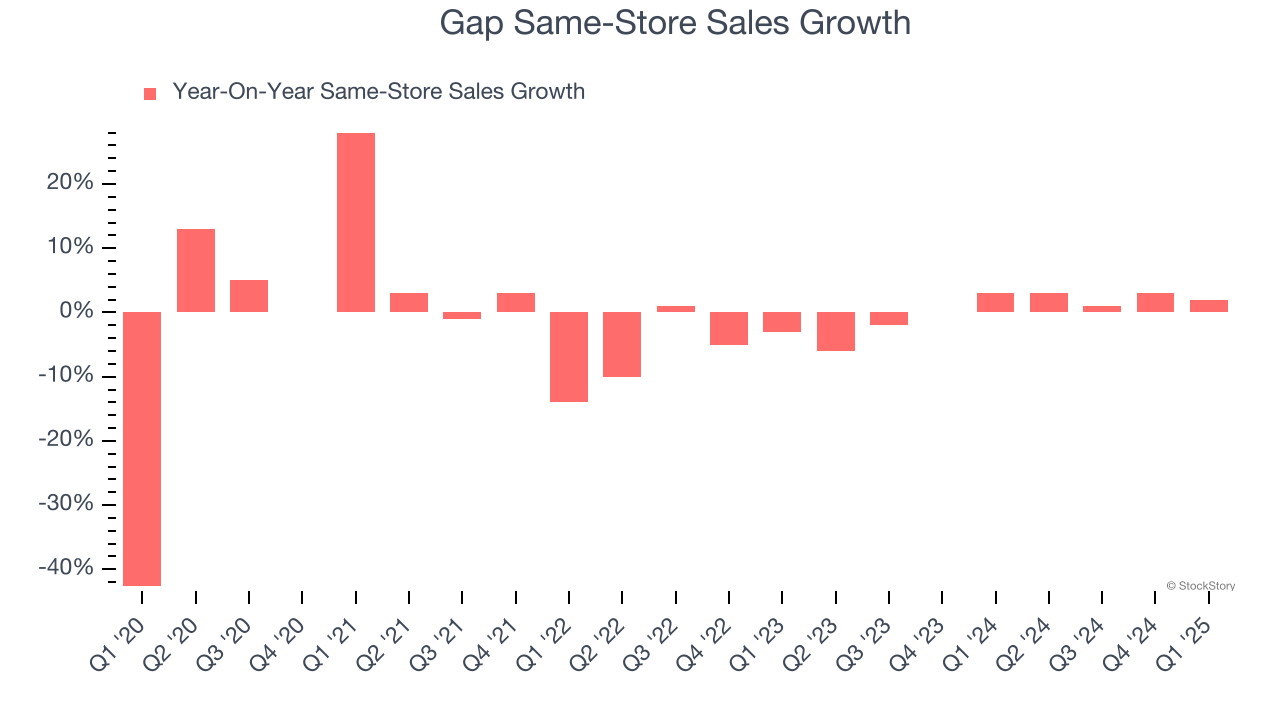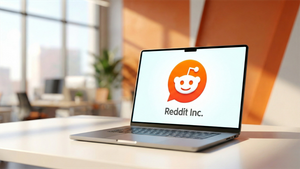
Clothing and accessories retailer Gap (NYSE: GAP) announced better-than-expected revenue in Q1 CY2025, with sales up 2.2% year on year to $3.46 billion. Its GAAP profit of $0.51 per share was 13.2% above analysts’ consensus estimates.
Is now the time to buy Gap? Find out by accessing our full research report, it’s free.
Gap (GAP) Q1 CY2025 Highlights:
- Revenue: $3.46 billion vs analyst estimates of $3.42 billion (2.2% year-on-year growth, 1.3% beat)
- EPS (GAAP): $0.51 vs analyst estimates of $0.45 (13.2% beat)
- Maintained previously provided fiscal 2025 guidance but added that "The below fiscal 2025 outlook does not reflect the potential effect of tariffs, which are currently 30% on most imports from China and 10% on most imports from other countries. If these tariff rates remain, they could result in a gross estimated incremental cost of approximately $250 million to $300 million."
- Operating Margin: 7.5%, up from 6.1% in the same quarter last year
- Free Cash Flow was -$223 million compared to -$63 million in the same quarter last year
- Locations: 3,496 at quarter end, down from 3,571 in the same quarter last year
- Same-Store Sales rose 2% year on year, in line with the same quarter last year
- Market Capitalization: $10.64 billion
"Gap Inc. delivered strong first quarter results, exceeding financial expectations and gaining market share for the 9th consecutive quarter," said President and Chief Executive Officer, Richard Dickson.
Company Overview
Operating under the Gap, Old Navy, Banana Republic, and Athleta brands, Gap (NYSE: GAP) is an apparel and accessories retailer selling casual clothing to men, women, and children.
Sales Growth
A company’s long-term sales performance is one signal of its overall quality. Any business can put up a good quarter or two, but many enduring ones grow for years.
With $15.16 billion in revenue over the past 12 months, Gap is one of the larger companies in the consumer retail industry and benefits from a well-known brand that influences purchasing decisions. However, its scale is a double-edged sword because there are only a finite number of places to build new stores, making it harder to find incremental growth. To expand meaningfully, Gap likely needs to tweak its prices or enter new markets.
As you can see below, Gap’s revenue declined by 1.4% per year over the last six years (we compare to 2019 to normalize for COVID-19 impacts) despite opening new stores and expanding its reach.

This quarter, Gap reported modest year-on-year revenue growth of 2.2% but beat Wall Street’s estimates by 1.3%.
Looking ahead, sell-side analysts expect revenue to remain flat over the next 12 months. While this projection indicates its newer products will spur better top-line performance, it is still below average for the sector.
Unless you’ve been living under a rock, it should be obvious by now that generative AI is going to have a huge impact on how large corporations do business. While Nvidia and AMD are trading close to all-time highs, we prefer a lesser-known (but still profitable) stock benefiting from the rise of AI. Click here to access our free report one of our favorites growth stories.
Store Performance
Number of Stores
The number of stores a retailer operates is a critical driver of how quickly company-level sales can grow.
Gap sported 3,496 locations in the latest quarter. Over the last two years, it has opened new stores quickly, averaging 2.4% annual growth. This was faster than the broader consumer retail sector.
When a retailer opens new stores, it usually means it’s investing for growth because demand is greater than supply, especially in areas where consumers may not have a store within reasonable driving distance.

Same-Store Sales
The change in a company's store base only tells one side of the story. The other is the performance of its existing locations and e-commerce sales, which informs management teams whether they should expand or downsize their physical footprints. Same-store sales is an industry measure of whether revenue is growing at those existing stores and is driven by customer visits (often called traffic) and the average spending per customer (ticket).
Gap’s demand within its existing locations has barely increased over the last two years as its same-store sales were flat. Gap should consider improving its foot traffic and efficiency before expanding its store base.

In the latest quarter, Gap’s same-store sales rose 2% year on year. This growth was an acceleration from its historical levels, which is always an encouraging sign.
Key Takeaways from Gap’s Q1 Results
We liked that Gap beat on revenue and EPS. On a headline basis, the company maintained previously-provided full-year guidance but added that "The below fiscal 2025 outlook does not reflect the potential effect of tariffs, which are currently 30% on most imports from China and 10% on most imports from other countries. If these tariff rates remain, they could result in a gross estimated incremental cost of approximately $250 million to $300 million." This is spooking the market, and the stock traded down 16.5% to $23.34 immediately after reporting.
Should you buy the stock or not? We think that the latest quarter is only one piece of the longer-term business quality puzzle. Quality, when combined with valuation, can help determine if the stock is a buy. We cover that in our actionable full research report which you can read here, it’s free.






